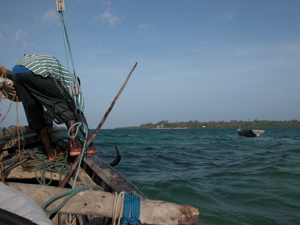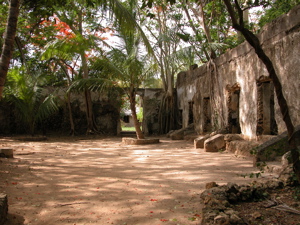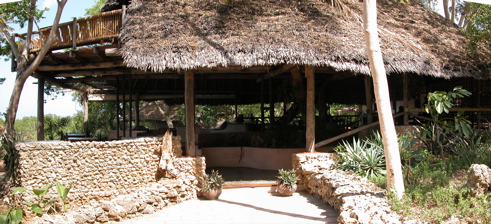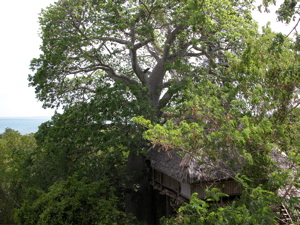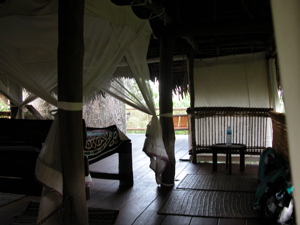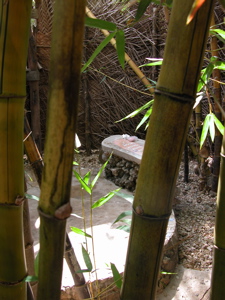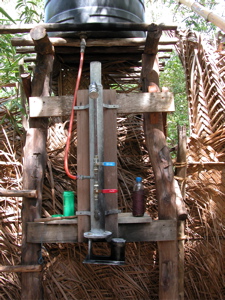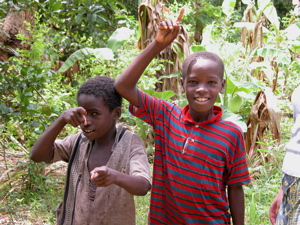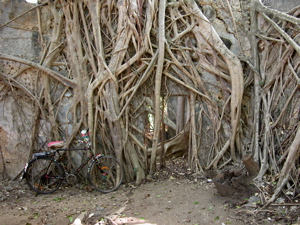
 |
travel@pangolin.liChole Mjini, Mafia, Tanzania
|
 |
 |
www.pangolin.li
home Travel directory Travel directory Tanzania '03 main Tanzania '03 main Sand Rivers, Selous Sand Rivers, Selous Chole Mjini
main Chole Mjini
main Chole Mjini
activites Chole Mjini
activites Zanzibar Zanzibar Gallery Gallery |
|
contact last updated: 28-Jan-2006 All text/pictures are subject to copyright by pangolin.li |
 |
 |
|||||||||||||||||||||||
| Click here for text-only version A treehouse lodge on a Robinson Crusoe island, amidst crumbling ruins overgrown by strangler figs and frangipani trees, surrounded by a spectacular marine national park, but also a project to sustain the local population and environment - this is Chole Mjini, on the southernmost archipelago, Mafia, in Tanzania.
How to get there
We arrived on Mafia Airport near the town of Kilondoni around noon. But our transport was nowhere to be seen - seems the guy had kind of disappeared a few days ago. Well, fully relaxed after a few days in Sand Rivers, we did what everybody else did: sit, wait, and watch the doings of the airport officials, Kilondonians and their chicken. No problem at all, and after a while Anne, the host of Chole Mjini appeared out of nowhere with a car and her shoppings, to take care of us. We were packed into the car, to bump for half an hour along beautifully green meadows, little villages, through the Marine National Park entrance and to the eastern shore of Mafia main island where our ferry waited. Well, the ferry is a dhow, an old but solid wooden sailing boat - and no pier to be seen. Anyway, this is what we expected, and luckily the sailors took care of our bags while we waded to the dhow. The boatride across a channel to Chole took ca. 20 minutes, and soon we could see the first treehouses. The dhow landed on a shallow sandbench near Chole's main square with soccer field, and we jumped into the water to wade over - the water being hip-high. A group of ladies sat in the shade of an old market hall, selling cool soft drinks, while the old men just sat under frangipani trees, waiting and watching the soccer game. We followed a sandy path past the ruins of a church, a jail and a merchant's house in the forest, to find the entrance to a less-crumbling ruin under a huge red-flowering tree. This was Chole Mjini. Back to top The Chole Mjini Lodge
The ruins enclose a court with old fig trees, but behind it are the long-awaited treehouses. The main house sits to the right on ground, offering sitting and a big table on ground floor, and a bar upstairs - no walls, everything is open-air. From the bar you can see the sea behind the island's mangrove belt, and suspicious thatching in baobab trees nearby: the treehouses. Well, the nearest guesthouse is built on ground. The other 6 "rooms" are the treehouses that lured us here. They are scattered so that you don't really notice them until you stand in front of one. The garden is very well kept, with little ground birds and chicken scurrying around. We had treehouse No. 1. It is built on stilts around a huge baobab tree, just above the waterline. The whole structure is built from wood planks, ropes and reed, and is open on three sides. Coming up the stairs, you enter the thatched platform where the bed with mosquito net, a trunk and an open cupboard to store stuff, a little table and a basin to wash are located. It opens up to a balcony shared with the baobab, with a bench and a view over the canopy of the mangroves. No sea to be seen, but a great place to read during the afternoon and watch the fruit bats and birds when the sun sets... On the platform, there is the basin to wash (though the soap might have mice teeth marks), and you get a bucket for a chamber pot at night. However, WC and shower are on the ground. The WC is a little cabin with a long-drop composting toilet. The real feature is the shower: It is an intimate little bamboo garden enclosed by bamboo walls, with a concrete basin inlaid with a mosaic. And, well, the preparation to take a hot shower includes lighting a jar of kerosene and push it under the hot-water pipe, and then mix the water until its temperature is bearable. Ingeniously efficient.
Being the only guests for most of our stay, we explored the other treehouses as well. The groundhouse No. 6 is the most luxurious, with Zanzibari-style beds, and sunken bathtubs, but still surrounded by a thatched wood-rope openair structure. It is too close to the main house, however. Not all of the other treehouses actually had a tree, and we considered ours the one with the most authentic treehouse feeling. The others were more sophisticated though, with second platforms accessible by ladders, with daybeds (or kid beds), with bigger balconies or views to the small beach, the sea and on to Mafia (No. 4). We took most meals in the main house - and we were surprised by the quality and variety of the food prepared by the local chef. It felt the most authentic during our trip, with lots of local fish, rice, spices, vegetables and fruit - most of it from Chole or Mafia. Lunch and dinner were usually taken together with the the hosts Jean and Anne, and their kids Didi and Maya. It felt really like home. Twice during our stay, we were treated to a candlelight dinner in the old ruins - very romantic! There is no electricity in the guest rooms, but you get petroleum lamps or torches. However, cameras and stuff can be charged from a generator at the dive base. This is also the communication hub, with radio to the mainland. The whole lodge is guarded day and night - whenever we left, a young man would come and read a book on the steps of our treehouse and guard it, to only retreat when we came back. You might wish to bring literature for him :-) Back to top The communityUpon our arrival in Chole, we noticed a group of women selling cold soft drinks out of a fridge. We soon learnt that this was an initiative of the local women comittee, to make some money for their families. But Anne also told us that, at first, this small business had been far from profitable, because the women didn't know that they should sell the drinks at a price higher than their buying price - so they first had to be trained in the essentials of business life and book-keeping!
The Chole Project was started by the de Villiers and Emerson Skeens, of Zanzibar, in 1993, as an approach to bring a truly social and sustainable form of tourism to this so far untouched island. Based on anthropological research, and with the help of many volunteers of various professions, the locals were trained to build the lodge, to run the daily business with tourists, but also to staff the school, hospital, kindergarden and business councils that were funded by proceeds from the lodge and sponsors. The UK-based charity The Tribes Foundation supports Chole with funds for schooling and the clinic - with a donation of GB£ 10 per month one student can be sent to secondary school! The clinic is supposed to be one of the best in the region, with even people from the mainland attending it. And the school produced two doctors recently, while in the previous generation, most pupils didn't go beyond primary education. About 100 of the 250 adults on the island get the bigger part of their income from the hotel - but on the other hand, the island's economy comes to a halt each year when the hotel is closed during the rainy season, only to re-boost when the new guests arrive. If I compare the life at Chole with what I learnt from letters of my Worldvision godchildren in Chad and Mocambique, then Chole must have made a huge step in the past 10 years. AfricanTravelResource provides a document by Jean de Villiers which gives much more backgroud about the project. Back to top Go to:
|
|||||||||||||||||||||||
 |

